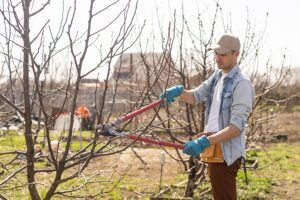Pruning seems like an easy task – just grab your hand pruners or loppers and go to it. Well, not so fast. When done properly, pruning not only improves the look of the plant and your yard, but will help maintain the health and beauty of your trees and shrubs. If done hastily and without forethought, it can cause irreversible damage and even kill the plant.
The real goal of pruning is to maximize the long-term health and growth of a tree or shrub.

Here are some common mistakes to avoid:
Pruning Before Planning
Before you start lopping, assess the plant you plan to prune. Some things to consider include the overall health of the tree or shrub. The health of the plant helps determine how much can be pruned off safely. Also think about the setting of the tree or shrub. If it’s near the house, do you want to maintain some shade from it, or do you need to get dangerous limbs away from the building. Is it part of a landscape design or garden bed and needs to be trimmed up accordingly, or is it part of your natural landscape and can have a more informal look.
Pruning should achieve a particular goal. Perhaps you need to remove dead limbs or attain a better shape, maybe pruning is to increase fruit or flower production. What’s important is that you prune with a plan so you don’t risk sacrificing the overall health of the plant. Pruning without a goal will cause damage to a tree or shrub. Think before you cut!
Improper Pruning Cuts
The most common mistake inexperienced pruners make is improper pruning cuts. Cutting too close to the trunk, called a flush cut, or cutting too far away from the trunk, called a stub cut, can cause irreversible damage. A flush cut leaves a large wound in the side of the tree that won’t heal properly. A stub cut leaves too much of the branch still on the tree. This will decay backward through the center of the root collar and into the trunk of the tree. Both of these damaging cuts result in decay, which could lead to plant death. Always cut just to the branch collar. This will minimize any damage and allows it to heal quickly.

Using Dull Tools
Using dull tools to prune will cause significant damage to a tree or shrub. Instead of a nice clean cut that will heal quickly, you will likely tear or rip the bark or leave a rough cut, both causing large wounds that traumatize the plant.
Topping a Tree
Cutting off the top of a tree is referred to as “topping”. The top of a tree is an essential part of its structure. Cutting off the top causes a lot of stress to the tree and can make it more likely to fall. Topping happens most often when a tree outgrows the space it’s planted in which is why it’s so important to consider the mature height of a tree before you plant it.
Over-Pruning
While it’s critically important not to over-prune during the growing season, over-pruning any time of year can stress a tree or shrub, making it susceptible to disease. Remember, every pruning cut you make is a wound to the plant. The plant must use resources to heal itself, and pruning live branches reduces a plant’s photosynthetic capacity, reducing it’s resources. Pruning wounds also create entry points for disease, decay and fungi to enter the tree and rot it from the inside. Too many pruning cuts can result in an over-stressed plant and possible death.
Pruning Shy?
As you can see, pruning isn’t quite as straightforward as it seems at first glance. If you value your trees and shrubs, it may be worth hiring a professional to come prune your plants for you. Another advantage to bringing in a pro is that we clean up all the debris after pruning and take it all away for you. When AC Yard Services pulls out of the driveway, all you’re left with is a tidy yard with happy, healthy trees and shrubs looking their best!
Call us today to schedule a pruning visit!